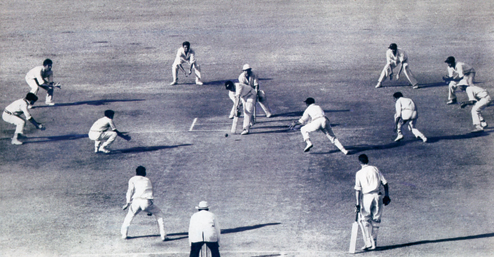Mid-wicket tales: From Trumper to Tendulkar
By S. Giridhar and V.J. Raghunath,
Sage, Rs 525
 |
Salim Durani had enchanted Indian cricket fans with silken skills in his playing days. He did a great service even in retirement, granting S. Giridhar and V.J. Raghunath — the authors whose witty, erudite essays make up this compilation — an interview in an airport. The gist of the conversation with Durani was, fortuitously, published by an editor, thereby announcing the welcome arrival of two new cricket writers in this burgeoning tribe. What sets Giridhar and Raghunath apart from their less gifted colleagues is their sense of balance. Not every essay in the collection presents original ideas. But the authors add the right amount of ingredients — anecdotes, history, statistics and analysis — to serve a broth that lovers of the game would find agreeable.
Giridhar and Raghunath are also blessed with vision that would make Hawk-Eye proud. Hence they are able to spot aspects of the game and its players that have been ignored. Take, for instance, the essay that celebrates not Kapil Dev’s deadly outswingers or hard-hitting but his ability to rotate the strike and his running-between-the-wickets. (The latter ability usually made life difficult for lazier batting partners such as Dilip Vengsarkar.)
Forgotten, but heroic, players are also resurrected to reveal how often a twist of fate separates the good from the great in cricket. Padmakar Shivalkar and Rajinder Goel, the two left-arm spinners who toiled relentlessly for Mumbai and Delhi (and Haryana), respectively, failed to earn a berth in the national team because of the presence of the peerless Bedi in the famous spin quartet.
Mid-wicket tales is also a trivia-hunter’s delight. Some of the startling facts that are revealed by the sleuth-like writers are as follows — the first great slip fielder in the history of Test cricket, the Australian Jack Gregory, was, ironically, a fast bowler; the googly, the nemesis of many a English batsman, was discovered by the Englishman, Bernard Bosanquet; right-arm fast bowlers have accounted for nearly 60 per cent of the Test wickets thus far, and so on. Mercifully, in spite of their wealth of knowledge, Giridhar and Raghunath resist the temptation to preach from the pulpit.
But it isn’t impossible to get through the authors’ defences. Their penchant to bolster their arguments with the help of statistical models is counterproductive because it adversely affects the delightful, anecdotal tone of the narrative. There is also room for improvement when it comes to consistency. The essay on Sachin Tendulkar, for example, adds nothing to what we already know about the great one and hence would disappoint the discerning reader. There is not much here for the serious reader in terms of the modern game’s sociological significance.
But then cricket-writers, like the players they write about, are not expected to win every contest.

